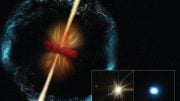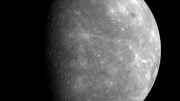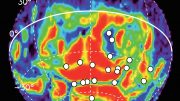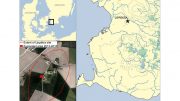
The above time-lapse approach movie was made from images from the Long Range Reconnaissance Imager (LORRI) camera aboard New Horizons spacecraft taken between May 28 and June 25, 2015. During that time the spacecraft distance to Pluto decreased almost threefold, from about 35 million miles to 14 million miles (56 million kilometers to 22 million kilometers). The images show Pluto and its largest moon, Charon, growing in apparent size as New Horizons closes in. As it rotates, Pluto displays a strongly contrasting surface dominated by a bright northern hemisphere, with a discontinuous band of darker material running along the equator. Charon has a dark polar region, and there are indications of brightness variations at lower latitudes.
NASA’s New Horizons spacecraft has detected frozen methane on Pluto’s surface.
Yes, there is methane on Pluto, and, no, it doesn’t come from cows. The infrared spectrometer on NASA’s Pluto-bound New Horizons spacecraft has detected frozen methane on Pluto’s surface; Earth-based astronomers first observed the chemical compound on Pluto in 1976.
“We already knew there was methane on Pluto, but these are our first detections,” said Will Grundy, the New Horizons Surface Composition team leader with the Lowell Observatory in Flagstaff, Arizona. “Soon we will know if there are differences in the presence of methane ice from one part of Pluto to another.”
Methane (chemical formula CH4) is an odorless, colorless gas that is present underground and in the atmosphere on Earth. On Pluto, methane may be primordial, inherited from the solar nebula from which the solar system formed 4.5 billion years ago. Methane was originally detected on Pluto’s surface by a team of ground-based astronomers led by New Horizons team member Dale Cruikshank, of NASA’s Ames Research Center, Mountain View, California.
This movie, from New Horizons’ highest-resolution imager, shows Pluto and Charon as the spacecraft closes in. In the annotated version, Pluto’s prime meridian (the region of the planet that faces Charon) is shown in yellow and the equator is shown in pink. Credit: NASA/Johns Hopkins Applied Physics Laboratory/Southwest Research Institute
“Alice” Instrument Practices for Sunset and Sunrise Observations of Pluto’s Atmosphere
The New Horizons spacecraft has made a critical observation in preparation for its upcoming observations of Pluto’s tenuous atmosphere. Just hours after its flyby of Pluto on July 14, the spacecraft will observe sunlight passing through the planet’s atmosphere, to help scientists determine the atmosphere’s composition. “It will be as if Pluto were illuminated from behind by a trillion-watt light bulb,” said Randy Gladstone, a New Horizons scientist from Southwest Research Institute, San Antonio. On June 16, New Horizons’ Alice ultraviolet imaging spectrograph successfully performed a test observation of the sun from 3.1 billion miles away (5 billion kilometers), which will be used to interpret the July 14 observations.
New Horizons is now less than 11 million miles (18 million kilometers) from the Pluto system. The spacecraft is healthy and all systems are operating normally.









Be the first to comment on "New Horizons Detects Methane on Pluto’s Surface"